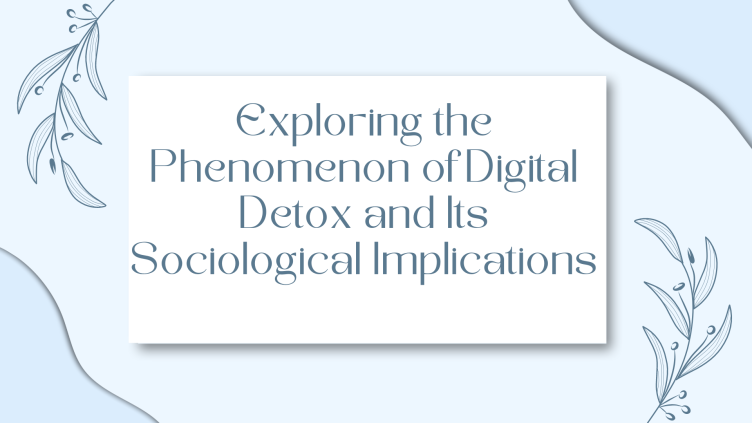In today’s hyper-connected world, the term “digital detox” has become a buzzword, symbolizing the need to disconnect from our screens and reconnect with the world around us. But what does digital detox mean, and why has it gained such traction? This article delves into the phenomenon of digital detox, examining its sociological implications and exploring how it reflects broader societal trends.
Understanding Digital Detox
A digital detox refers to a period during which an individual voluntarily reduces or eliminates their use of digital devices such as smartphones, computers, and social media platforms. The goal is to decrease stress, improve mental health, and enhance real-life social interactions. The rise of this practice mirrors growing concerns about the impact of digital technologies on our daily lives.
The Rise of Digital Overload
The average person spends around 7-9 hours a day on digital devices. This includes time spent on work-related tasks, social media, streaming services, and other online activities. The sheer volume of screen time has led to concerns about digital overload, a state where constant exposure to digital stimuli causes mental and physical fatigue.
Example: The Impact of Social Media
Consider social media, a prime example of digital overload. Platforms like Facebook, Instagram, and Twitter are designed to keep users engaged for as long as possible. The endless scroll feature, notifications, and algorithm-driven content keep us hooked. A study by the Royal Society for Public Health in the UK found that social media use is linked to increased rates of anxiety, depression, and poor sleep among young people.
The Sociology of Digital Detox
From a sociological perspective, the digital detox movement can be seen as a reaction to the pervasive influence of technology on social structures and relationships. Here are some key sociological implications:
1. Reclaiming Social Connections
One of the primary motivations for digital detox is the desire to reclaim face-to-face social interactions. In a world where virtual communication often takes precedence over in-person conversations, digital detox provides a means to restore balance. By unplugging, individuals can foster deeper, more meaningful connections with family and friends.
Example: Family Time Without Screens
A study by Common Sense Media found that 47% of parents are concerned about their children’s screen time. Many families are now adopting screen-free days or hours to encourage more family bonding time. Activities like board games, outdoor adventures, and shared meals become opportunities for real interaction, enhancing familial relationships.
2. Mental Health and Well-being
Digital detox is also seen as a response to the mental health challenges posed by constant connectivity. The pressure to be always available and responsive can lead to burnout, stress, and anxiety. By taking a break from digital devices, individuals can focus on self-care and mental well-being.
Example: Corporate Digital Detox Programs
Some companies have recognized the benefits of digital detox for employee well-being. Organizations like Volkswagen and Daimler have implemented policies to limit after-hours email access, helping employees disconnect from work and reduce stress. These initiatives highlight the growing recognition of the importance of mental health in the workplace.
3. Consumerism and Digital Minimalism
The digital detox movement is closely linked to the concept of digital minimalism, which advocates for a more intentional and mindful use of technology. This philosophy challenges the consumerist culture that drives the constant upgrading of devices and the pursuit of the latest apps and gadgets.
Example: The Rise of Dumb Phones
In recent years, there has been a resurgence in the popularity of “dumb phones” – basic mobile phones with limited features. These devices are favored by those seeking to reduce their digital footprint and avoid the distractions of smartphones. The shift towards digital minimalism reflects a broader trend towards simplicity and intentional living.
Digital Detox in the Modern Age
The relevance of digital detox in contemporary society cannot be overstated. As technology continues to evolve, the need for mindful usage becomes even more critical. Here are some current trends and examples that highlight the importance of digital detox today:
The Pandemic and Increased Screen Time
The COVID-19 pandemic has significantly increased our reliance on digital technologies. With remote work, online learning, and virtual socializing becoming the norm, screen time has surged. This shift has brought to light the importance of setting boundaries and taking breaks from digital devices to prevent burnout.
Example: Virtual Meetings and Zoom Fatigue
The rise of virtual meetings during the pandemic has led to a phenomenon known as “Zoom fatigue.” A study by Stanford University found that excessive video conferencing can cause mental exhaustion due to prolonged eye contact, lack of mobility, and the cognitive load of interpreting non-verbal cues. To combat this, some organizations are implementing “no meeting” days to encourage employees to take breaks from their screens.
Digital Detox Tourism
Digital detox has also given rise to a niche tourism market. Many resorts and travel destinations now offer digital detox packages, where guests are encouraged to disconnect from their devices and immerse themselves in nature and offline activities. These retreats cater to individuals seeking a break from the digital grind and a chance to recharge.
Example: Camp Grounded
Camp Grounded is a digital detox retreat that offers participants the opportunity to unplug and engage in activities like hiking, yoga, and creative workshops. Attendees are required to surrender their digital devices upon arrival, fostering an environment of genuine human connection and mindfulness.
The Future of Digital Detox
As we move forward, the concept of digital detox will likely continue to evolve. Here are some potential future trends:
Integration with Digital Wellness
Digital wellness is an emerging field that focuses on promoting healthy digital habits. Future digital detox initiatives may integrate more seamlessly with digital wellness programs, offering comprehensive strategies for balanced technology use.
Example: Digital Well-being Apps
Apps like Moment, Forest, and Digital Detox help users monitor and manage their screen time. These tools provide insights into usage patterns and offer tips for reducing screen time, supporting a balanced approach to technology.
Education and Awareness
Increasing awareness about the importance of digital detox will be crucial. Educational campaigns, workplace training, and community programs can help individuals understand the benefits of unplugging and provide practical tips for implementing digital detox in their lives.
Example: School Programs
Some schools are introducing digital detox programs to help students develop healthy screen habits. Activities like screen-free days, mindfulness exercises, and outdoor learning experiences encourage students to engage with the world beyond their screens.
Conclusion
The phenomenon of digital detox reflects a growing awareness of the need to balance our digital and real-world lives. By exploring its sociological implications, we can better understand the impact of technology on our social structures, mental health, and cultural practices. As we navigate the digital age, embracing mindful technology use and incorporating digital detox into our routines can help us lead healthier, more fulfilling lives.
In our fast-paced, digitally driven society, taking a step back to unplug and reconnect with the world around us is not just a trend but a necessary practice for our overall well-being. So, the next time you find yourself reaching for your phone out of habit, consider taking a moment to pause, breathe, and embrace the benefits of a digital detox.







